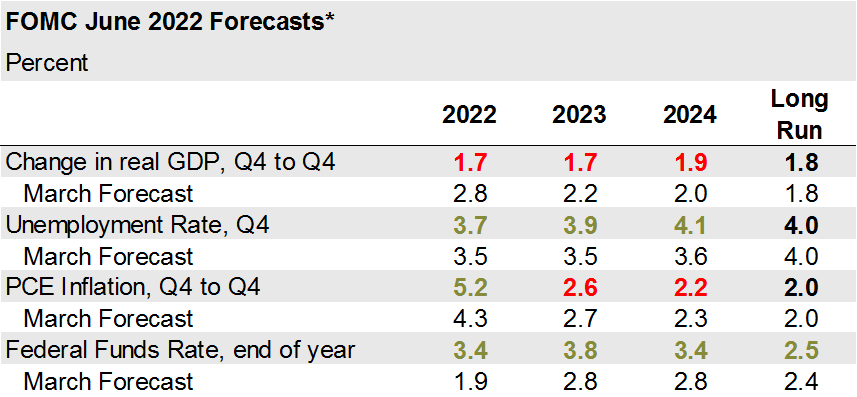Written by: Jordan Jackson
At its June meeting, the Federal Open Market Committee (FOMC) voted to raise the Federal funds target rate range by 0.75%, the largest increase since 1994, to 1.50%-1.75% and kept the door open for another 75bp increase at its July meeting. The message from the committee is clear, the Fed will expeditiously raise interest rates given it is “strongly committed” to tame inflation. While the Fed believes it can be successful in its efforts without tipping the economy into recession, this week’s actions clearly increase the risk of a recession starting later this year or in 2023.
The committee also delivered hawkish forward guidance through its Summary of Economic Projections and median “dot” plot. Relative to their mid-March forecasts:
- Real GDP growth by the fourth quarter of 2022 was revised lower from 2.8% to 1.7%, with that slower pace of growth being sustained through 2023.
- Headline and core consumption deflator inflation for the fourth quarter of 2022 was raised from 4.3% to 5.2% and 4.1% to 4.3%, respectively. Thereafter, inflation is still expected to cool meaningfully next year and in a relatively stable manner in 2024.
- The unemployment rate forecast was edged higher this year and next to 3.7% and 3.9%, respectively.
- The median “dot” plot forecasts the end-of-2022 federal funds rate at 3.4% and 3.8% in 2023, before having to cut rates back to 3.4% in 2024.
These revisions largely reflect the evident persistent inflationary pressures and to some extent the first-quarter slide seen in both real GDP and productivity. While the labor market continues to expand and growth is expected to recover through the middle of this year, the committee recognizes the aggressive path of rate hikes will cool demand for labor and act as another drag on the overall economy into next year.
Importantly, there are no doves left on the committee given no FOMC members see the Federal funds rate lower than 3% by end of the year. Given inflation may remain elevated through the summer, it seems plausible the Fed will hike rates by 75bps in July, 50bps in September, followed by 25bp increases in November and December.
For investors, the Fed has laid out a hawkish path for rate increases with the intent to front load rate hikes. With such aggressive tightening this year, recession risks have risen further in 2023. Given this and the year-to-date move higher in yields, high-quality intermediate to long duration core bonds may be the most attractive fixed income asset class to consider at this stage. To be clear, the Fed could avoid a recession, however the runway for a soft landing is much narrower than it was just a few weeks ago.

Related: Are You Worried About an Earnings Recession?
Source: Federal Reserve, J.P. Morgan Asset Management. Data are as of June 15, 2022.
*Forecasts of 18 FOMC participations, median estimate.
**Green denotes an adjustment higher, red denotes an adjustment lower.


